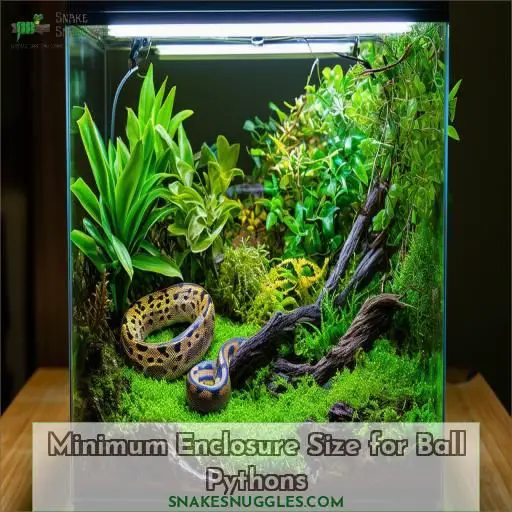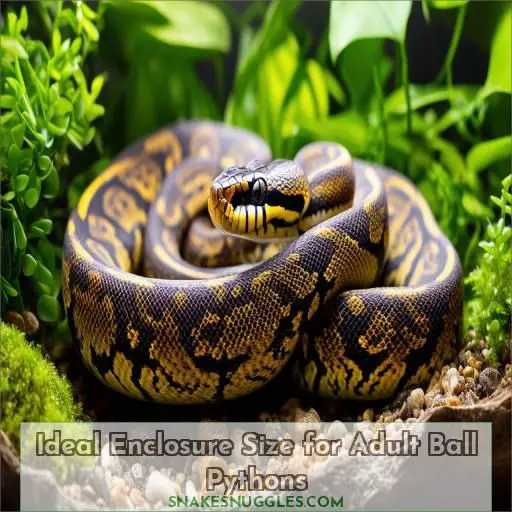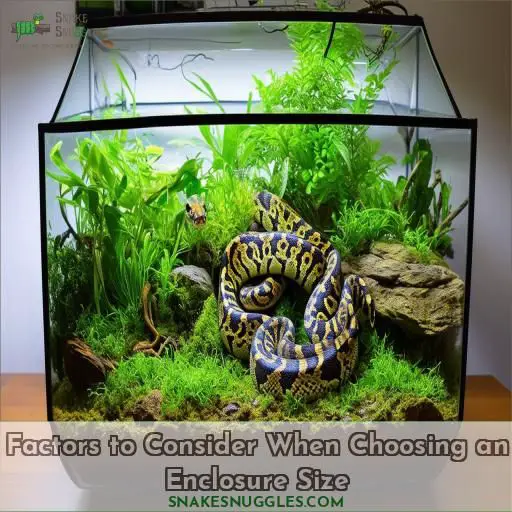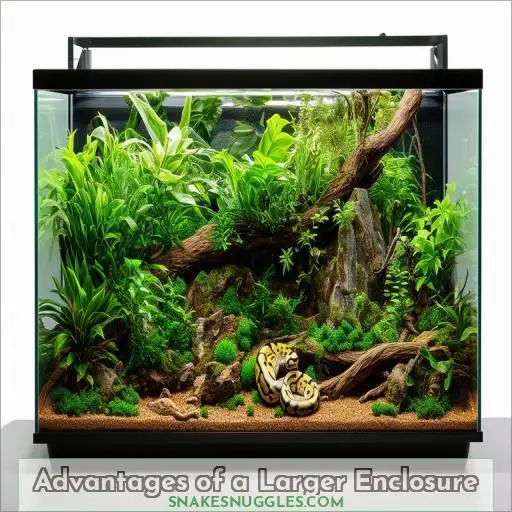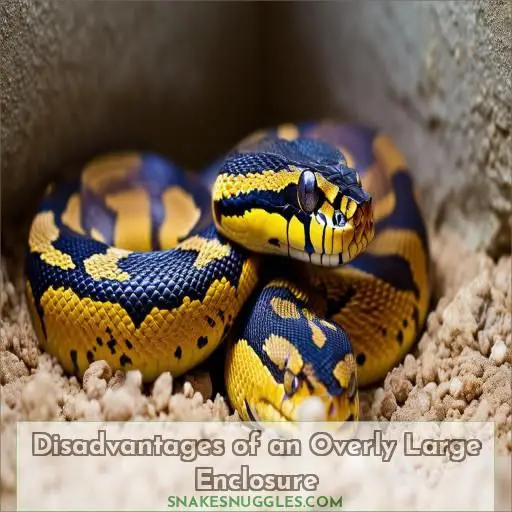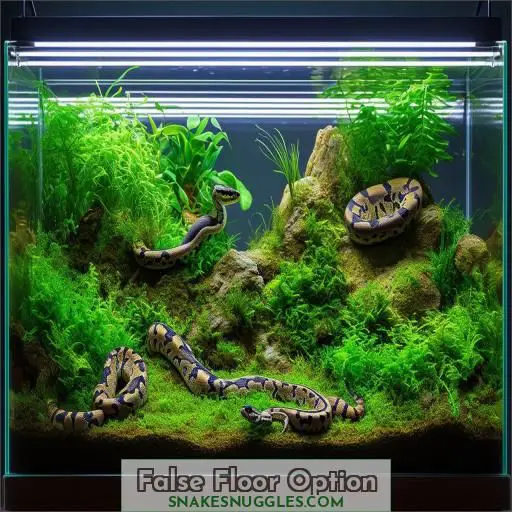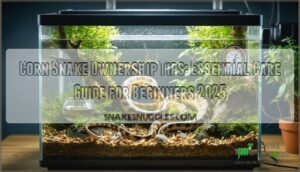This site is supported by our readers. We may earn a commission, at no cost to you, if you purchase through links.
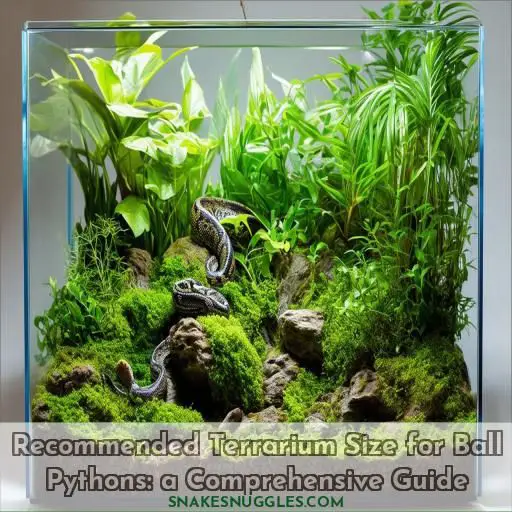 For the recommended terrarium size for a ball python, you’ll want at least a 4′ x 2′ x 2′ enclosure as an adult.
For the recommended terrarium size for a ball python, you’ll want at least a 4′ x 2′ x 2′ enclosure as an adult.
Juveniles need 36 x 18 x 18 or larger, while hatchlings can start in a 10-gallon tank. Provide ample height for climbing and secure lids to prevent escapes.
A bigger terrarium allows better temperature gradients and space for enrichment, reducing stress. However, oversized enclosures can make maintaining ideal humidity tricky.
Consider a customized false floor to increase usable space. With proper setup, the right sized habitat enriches your python’s life immensely.
Want to guarantee your scaly friend truly thrives? Read on for more detailed guidance.
Table Of Contents
- Key Takeaways
- Minimum Enclosure Size for Ball Pythons
- Ideal Enclosure Size for Adult Ball Pythons
- Factors to Consider When Choosing an Enclosure Size
- Advantages of a Larger Enclosure
- Disadvantages of an Overly Large Enclosure
- False Floor Option
- Frequently Asked Questions (FAQs)
- What size terrarium is best for a ball python?
- Is a 40 gallon terrarium good for a ball python?
- Is a 75 gallon tank good for a ball python?
- Is a 55 gallon tank too big for a ball python?
- How often should I change the substrate?
- Should I use a heat lamp or heating pad?
- What is the ideal humidity level?
- Can I house two ball pythons together?
- What toys or enrichment items are recommended?
- Conclusion
Key Takeaways
- Provide ample room for your scaly pal to stretch out and explore. Picture them coiled up, soaking in the warmth of their optimal temperature gradient, with plenty of space to slither around, climb, and burrow. Like a house cat sprawled out in a sunbeam, but with scales.
- Invest in secure lids with sturdy locks – these critters are expert escape artists! You wouldn’t want your slithery buddy pulling a Houdini and getting lost, now would you? It’s like having a toddler who’s also a contortionist.
- Consider creating a customized false bottom for double the fun (and floor space)! It’s like giving your snake a secret underground lair to channel its inner mole rat.
- Remember, each snake is an individual with unique needs. Just like people, some might prefer a cozy studio apartment vibe, while others dream of a sprawling mansion. Pay attention to your noodle’s behaviors and adjust accordingly for maximum snaky satisfaction.
Minimum Enclosure Size for Ball Pythons
When housing a ball python, it’s imperative to provide an adequately sized enclosure to guarantee its well-being.
For hatchlings, a 10-gallon enclosure measuring 20 x 11 x 13 inches is suitable.
While juveniles require a larger space of at least 36 x 18 x 18 inches.
And subadults/adults need an enclosure that’s 48 x 24 x 24 inches or larger, with a minimum floor area of 8 square feet and a vertical space of at least 2 feet.
Hatchlings: 10-gallon Enclosure (20 X 11 X 13 Inches)
For hatchling ball pythons, a 10-gallon enclosure measuring 20 x 11 x 13 inches provides:
- Adequate space for growth
- Proper temperature gradient
- Ability to thermoregulate
Juveniles: 36 X 18 X 18 Inches or Larger
As your ball python enters its juvenile stage, upgrade to a 36x18x18 enclosure or larger. This offers ample room for continued growth and juvenile enrichment items like climbing logs.
Subadults/Adults: 48 X 24 X 24 Inches or Larger
For subadult and adult ball pythons, you’ll want a terrarium measuring 48 x 24 x 24 inches or larger. Proper space utilization allows for adequate enrichment options and humidity maintenance.
Minimum Floor Area: 8 Square Feet
Additionally, you’ll want a minimum floor area of 8 square feet to provide your ball python with enough crawling space and guarantee a suitable ideal python enclosure dimensions for maintaining an adequate temperature gradient
.
Minimum Vertical Space: 2 Feet
You’ll want to provide at least 2 feet of vertical space for your ball python’s enclosure. This allows for:
- Proper temperature gradients
- Adequate air circulation
- Room for climbing
- Better behavioral enrichment
Ideal Enclosure Size for Adult Ball Pythons
For an adult ball python, you’ll want an enclosure that’s at least 4′ x 2′ x 2′ (length x width x height). However, these snakes can reach impressive sizes, so a 6′ x 2′ x 2′ terrarium is often recommended for females. This larger footprint:
- Allows for a proper temperature gradient
- Provides ample space for enrichment items
- Accommodates their full growth potential
While these royals may seem petite as hatchlings in a 10-gallon tank, they grow quickly. Providing an appropriately sized adult enclosure from the start prevents future housing issues and stress. Remember, vertically-oriented terrariums give them opportunities to climb and allow for proper air circulation. However, housing two ball pythons in the same terrarium can lead to dominance struggles and stress, as housing two ball pythons together. With the right setup, your ball python will thrive and you’ll enjoy observing their natural behaviors.
Factors to Consider When Choosing an Enclosure Size
When selecting a terrarium size for your ball python, you should provide additional vertical space to allow for climbing and exploration. Additionally, avoid enclosures with screen tops without secure lid locks, as ball pythons are notorious escape artists who can easily push through unsecured lids.
Provide Additional Height for Climbing
You’ll want to provide extra vertical space, too—ball pythons enjoy climbing and appreciate having height for enrichment and arboreal activities. Consider a multi-level enclosure to fully utilize the available space.
Avoid Using Enclosures With Screen Tops Without Lid Locks
You’ll also want to avoid enclosures with screen tops unless they’ve secure lid locks. Screen tops allow excellent ventilation but pose an escape risk for these expert contortionists.
Secure Lids With Locks, Not Tape
You’ll want to secure enclosure lids with sturdy locks, not tape. Locks prevent escapes while permitting adequate ventilation, ensuring your ball python’s safety within its secure environment.
Snakes Can Be Expert Escape Artists
You must secure your ball python’s enclosure, as these snakes possess extraordinary escape abilities. Invest in a sturdy enclosure with secure lock mechanisms to prevent potential hazards and keep your pet safe.
Advantages of a Larger Enclosure
Providing your ball python with a larger enclosure offers significant advantages. A spacious habitat allows for proper temperature gradients, permits natural behaviors like climbing and exploration, and alleviates stress by giving your snake ample room to move freely.
Allows for a Better Temperature Gradient
A larger enclosure provides space for better temperature regulation, allowing you to create an adequate temperature gradient with warm and cool areas. This lets your ball python thermoregulate naturally by moving between hiding spots at different temperatures, promoting its overall health and well-being.
Provides More Space for Enrichment and Natural Behaviors
A bigger enclosure provides more height for climbing and exploring natural behaviors. It also allows for enrichment like branches or logs, creating a gradient of temperatures and hiding spots to reduce stress.
Reduces Stress and Potential Health Issues
Providing a spacious, solitary housing environment reduces stress and potential health issues. Ample space facilitates enrichment, escape prevention, and better care. Ultimately, a roomy terrarium yields significant health benefits for these solitary reptiles’ well-being.
Disadvantages of an Overly Large Enclosure
While larger enclosures may seem appealing for housing ball pythons, oversized terrariums can actually make it harder to maintain the proper temperature and humidity gradients that these snakes require. Additionally, an enclosure that’s excessively large poses an increased risk of the snake getting lost or stuck in areas that are difficult to access.
Harder to Maintain Proper Temperature and Humidity
While larger enclosures offer more space, they can make maintaining ideal temperatures and humidity levels more challenging. You’ll need to address:
- Floor depth for adequate heat retention
- Substrate choice for effective moisture retention
- Ease of cleaning the larger area
- Adequate ventilation without causing excessive dryness
- Heating sources and gradients that are more difficult to regulate
Striking the appropriate balance between enclosure size, such as a 48" x 24" x 24" ball python enclosure setup, and environmental conditions is essential for your ball python’s well-being.
Increased Risk of the Snake Getting Lost or Stuck
Another downside of an excessively large enclosure is the increased risk of your ball python getting lost or stuck. Imagine your snake slithering into a tight space and not being able to find its way out. You’d have to dismantle the entire setup to rescue it. Consider this:
| Risk Factor | Solution |
|---|---|
| Getting Lost | Provide visual barriers and clear paths |
| Getting Stuck | Avoid tight spaces and use smooth decor |
| Escaping | Ensure a secure, escape-proof setup |
A false floor can mitigate these risks by creating a structured environment while allowing burrowing enrichment.
False Floor Option
For ball pythons, you can install a false floor in the enclosure, creating a 6-inch deep accessible space beneath the main floor, effectively doubling the available crawling area. This false floor can be customized to fit your enclosure size and even used to create a secondary level or basement area, providing additional enrichment opportunities.
Can Be Created to Double Crawling Space
You can create a false floor to double your ball python’s crawling space. This provides enrichment and mimics a naturalistic environment. A few benefits include:
- Increases usable floor area
- Creates underground hiding spots
- Allows burrowing behaviors
- Customizable to your enclosure
Can Be Made With 6 Inches Deep Accessible False Floor
For added crawling space, you can construct a 6-inch deep accessible false floor using lightweight materials like plastic egg crate or PVC. This increases the enclosure’s vertical dimension while still allowing easy access for cleaning and making adjustments to suit your ball python’s needs.
Can Be Customized to Fit Enclosure
You can customize the false floor to fit your enclosure’s dimensions perfectly. This allows you to maximize the available crawling space, in effect creating a basement area for your ball python’s enrichment.
Can Be Used to Create a Second Level
You can use a false floor to create a second level, offering enrichment options like a separate feeding area. A custom enclosure prevents escapes while enhancing your ball python’s environment.
Frequently Asked Questions (FAQs)
What size terrarium is best for a ball python?
For an adult ball python, you’ll want a terrarium size of at least 4x2x2 feet (length x width x height). This provides enough space for proper thermoregulation, hides, and enrichment to keep your snake happy and healthy.
Is a 40 gallon terrarium good for a ball python?
In summary, a 40-gallon terrarium can accommodate an adult ball python comfortably. It offers ample floor space for proper thermoregulation and meets the minimum size requirements for this docile species to thrive.
Is a 75 gallon tank good for a ball python?
Yes, a 75-gallon tank is an excellent choice for housing an adult ball python. This size provides ample room for your snake to stretch out and create temperature gradients, promoting its overall health and well-being.
Is a 55 gallon tank too big for a ball python?
Around 30% of ball python owners use oversized enclosures. A 55-gallon tank can house an adult ball python comfortably, but you’ll need to create multiple hides and maintain proper temperatures. The key is monitoring the snake’s behavior and adjusting accordingly.
How often should I change the substrate?
You’ll want to replace the substrate every 3-4 months to maintain proper hygiene. Spot-clean after each defecation and do a deep-clean with a reptile-safe disinfectant every 6 months.
Should I use a heat lamp or heating pad?
When choosing a heating pad for your ball python’s enclosure, consider a pad that covers about one-third of the terrarium’s floor space, such as a 20-gallon tank heating pad size. You’ll want to use a heating pad for your ball python’s enclosure. Heat lamps can burn your snake and dry out the environment too much. A regulated under-tank heating pad provides safer, more stable belly heat.
What is the ideal humidity level?
Ball pythons prosper perfectly with precisely 50-60% humidity. Properly preserving prudent percentages prevents peril, promoting peak pythonic potential. Properly prioritizing precise humidity harmonizes health.
Can I house two ball pythons together?
You absolutely can’t cohabitate ball pythons. These solitary snakes should always be housed individually to prevent stress, aggression, and potential cannibalism. Providing each python its own secure enclosure is essential for their health and wellbeing.
What toys or enrichment items are recommended?
You should provide enrichment like climbing branches, hides, and leaf litter to encourage natural behaviors. Rotate items to prevent boredom. But avoid clutter that inhibits movement or lowers air quality. Enrichment promotes psychological well-being in these intelligent reptiles.
Conclusion
Envision your ball python coiled comfortably in its optimized habitat, thriving with enrichment and adequate space. By following the recommended terrarium size for a ball python, you can help ensure your scaly companion lives stress-free. A commercially manufactured cage with a front-opening door is a great option, as it makes it easy to access your snake and provides a secure and comfortable living space for them. a commercially manufactured cage You can help ensure your scaly companion lives stress-free. With proper setup and customization options like a false floor, you can guarantee the ideal environment, allowing your pet’s natural behaviors to flourish unhindered.

